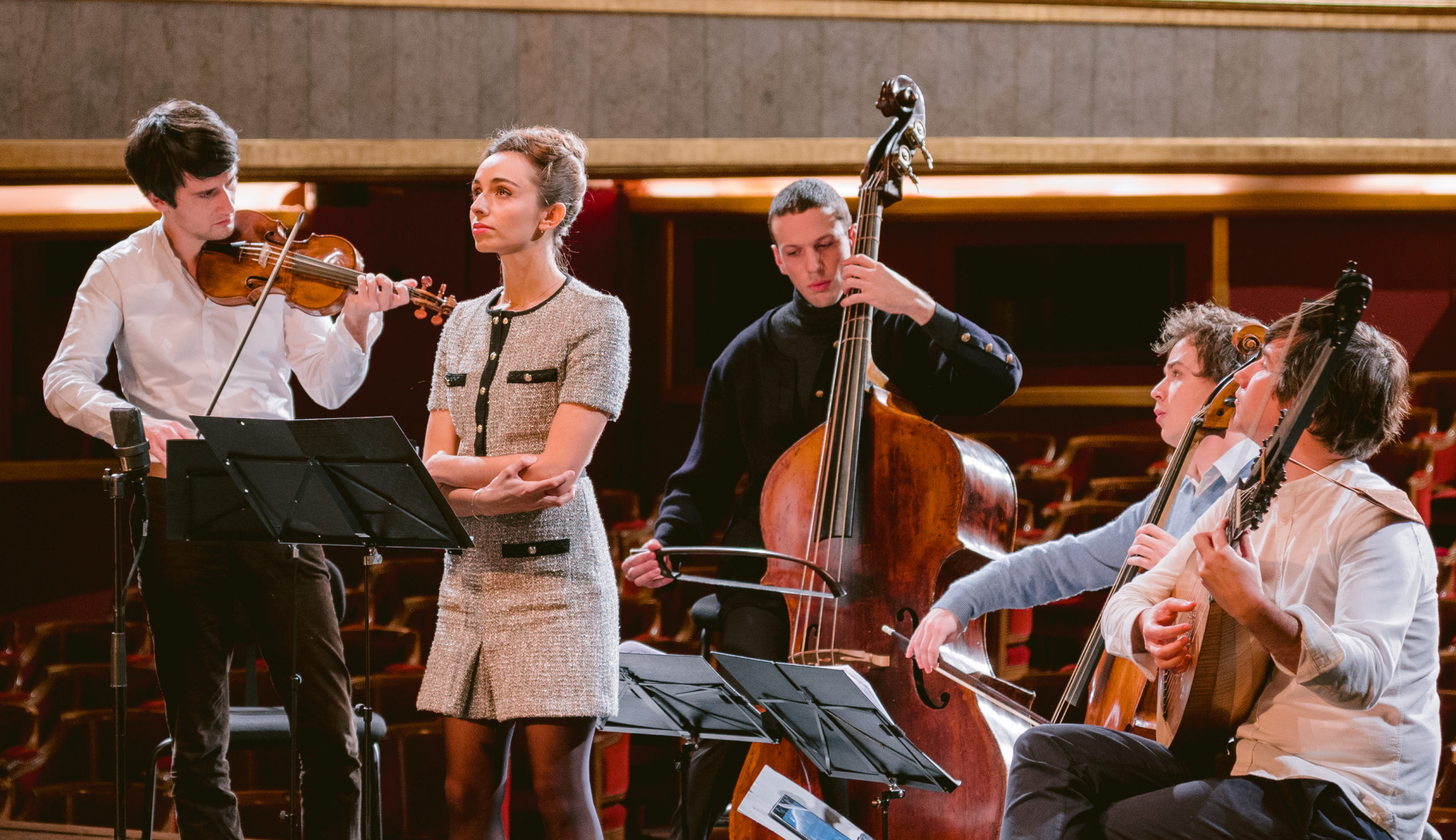Welcome to our 2024-2025 season!

Get directions, see parking and accessibility info, download a seating charts, and more.
Bringing world-class music into your life beyond the walls of a concert hall—
Virtual programs that connect you to the artists you love, anywhere you are—
We invite students of all ages to discover and deepen a love for live music!
Your support is critical to our future— thank you for making the gift of music.
Make DonationThrough innovative programs presented in an intimate setting, PUC has been committed to making classical music accessible to all since 1894.
We'd love to hear from you!
Contact UsProgram Notes
By Lucy Caplan
Lucy Caplan is a Lecturer on History and Literature at Harvard University. In 2016 she received the Rubin Prize for Music Criticism.
When describing their musical ethos, members of the Jupiter Ensemble tend to reach beyond the borders of genre. The group, says lutenist and director Thomas Dunford, is “as spontaneous as a jazz band.” Mezzo-soprano Lea Desandre has described its repertoire as “the ‘pop’ of the eighteenth century.” Dunford has also compared other collaborative projects with Baroque musicians as having “so much energy, like in rock ‘n’ roll.” What’s striking about these comparisons is that they have little to do with what this music sounds like (when was the last time you heard a jazz lute?) and much more to do with how it’s made. Emphasizing the music’s spirit, freedom, and appeal to listeners, these descriptions gesture toward an approach to music-making that is rooted less in recreating the past—so often presumed to be the goal of performers of early music—and more in creating something new in the present.
This imaginative approach is especially refreshing when it comes to so well known a composer as Antonio Vivaldi. Although Vivaldi’s music was largely ignored for centuries after his death, it has now become deeply familiar to modern audiences, a staple of music-education curricula, recordings, and performances. This evening’s program focuses less on the Vivaldi who is a stalwart of textbook examples and more on the Vivaldi who was a virtuoso violinist, an extroverted presence on the Italian musical scene, and an exuberant self-plagiarizer who borrowed freely from his own compositions to make new ones. His music is creative in the most fundamental sense: It doesn’t so much transport us to a distant past as it attunes us to the incomparable joy of making music with others.
“Vedrò con mio diletto” from Il Giustino, RV 717 (1724)
An ultrapowerful goddesses, a Byzantine emperor, a marauding bear—Vivaldi’s 1724 opera Il Giustino has all the ingredients, and then some, for an epic work of music theater. Written for the Rome carnival, the piece is ornate and extravagant on a vast scale. At its core, this aria is a love song, in which the emperor expresses his love for his companion and laments that they must soon part. Written in a classic ABA form, it allows the singer’s voice to soar over a rhythmic, staccato accompaniment.
“Armatae face et anguibus” from Juditha triumphans, RV 644 (1716)
Vivaldi wrote an enormous number of concertos and dozens of operas, but just four oratorios. Juditha triumphans is the only one that survives, making it a remarkable and atypical work within Vivaldi’s vast oeuvre. Written for the girls’ school where the composer worked at the time, the piece featured a Latin text, a Biblical story, four female soloists, and an unusually multifarious orchestra, which included such instruments as the mandolin, theorbo, and viola d’amore. In this bellicose aria, a servant demands retribution after discovering the decapitated body of the general he serves.
Lute Concerto in C Major [adaptation of the Trio Sonata in C Major, RV 82 (c. 1730)]
Adapted from a trio sonata, this amiable “lute concerto” showcases the lute alongside a violin and basso continuo. Likely written for a Bohemian count, Johann Joseph Von Wrtby, who had a fondness for the lute, the work proceeds with elegance and cheer across its three movements. Two major-key allegro movements frame a more somber larghetto, in which the lute’s mournful dotted rhythms are juxtaposed with the violin’s steady, repeated melodic patterns.
“Cum dederit” from Nisi Dominus, RV 608 (1710s)
In the multi-movement solo cantata Nisi Dominus, Vivaldi sets varied texts from Psalm 127 for a mezzo-soprano and a group of strings. The swaying siciliana rhythms of this movement, “Cum dederit,” evoke and amplify the words of the text (“for so he giveth his beloved sleep”). Far from a simple lullaby, though, the piece mixes tranquility with flashes of dissonance, as the soloist lingers on chromatic passing tones to create a sense of pious gravity.
Lute Concerto in D Major, RV 93 (1730s)
By the 1730s, Vivaldi had the professional security and freedom to leave his home in Venice and travel across Europe. This concerto, which dates from that period, was likely written while the composer was traveling in Bohemia. Buoyant and animated, the first movement is propelled by an energetic bass line. The second movement melts into a more relaxed mood, with shimmering chords accompanying the lute’s meditative melody. The final movement is a quick-paced dance in compound meter, bringing the piece to an exuberant close.
Violin Concerto in F Minor, “L’Inverno” (Winter), RV 297 (1716–1725)
Among the best-known works not only by Vivaldi, but of the Western art music repertoire in general, The Four Seasons retain an enduring appeal. Unlike the vast majority of Vivaldi’s instrumental works, they are programmatic, meant to illustrate four accompanying sonnets. In the final of the four concertos, L’Inverno, the first movement evokes “shivering” and “bitter chill”; in the second movement, the solo violin rests peacefully indoors by a fire, while pizzicato figures in the orchestra remind us of the rainstorm outside. The third movement traverses an “icy path,” and the violin’s ominous running figurations navigate the perilous conditions before finally finding safety.
“Gelido in ogni vena” from Farnace, RV 711 (1727)
The icy dissonances that introduce this aria seem to be taken straight from L’Inverno, exemplifying Vivaldi’s penchant for reusing musical material across various works. It is part of an opera whose layered tragedies—a defeated king, a captured princess—all ultimately resolve to a happy ending. The aria, in which the title character wrongly believes that he has caused his son’s death, moves from trembling fear to deeply felt anguish.
“Gelosia, tu già rendi l’alma mia” from Ottone in villa, RV 729 (1713)
By the time he wrote his first opera, Ottone in villa, in 1713, Vivaldi was already an established figure on the Venetian musical scene, renowned as both a violinist and composer. The work, with its appealing music and intricate story of ancient Rome, was an immediate hit. It is rife with virtuosic showpieces like “Gelosia,” in which a case of mistaken identity prompts one character to seethe about his lover’s apparent infidelity.
Cello Concerto in G Minor, RV 416 (c. 1708)
A prolific composer of concertos, Vivaldi wrote more than two dozen such works for the cello—an unusual decision at a time when solo works for the instrument were rare. In this concerto, the soloist and ensemble trade phrases at a breakneck pace in the first movement, then let the cello take center stage for the openhearted Adagio. The final movement is joyful, bubbling over with energy and vigor.
“Onde chiare che sussurrate” and “Scenderò, volerò, griderò” from Ercole su’l Termodonte, RV 710 (1723)
In Ercole su’l Termodonte (Hercules on the Thermodon), Vivaldi reinvents an ancient Greek story, in which Hercules is tasked with seizing the sword of an Amazon queen, for the operatic stage. In the pastoral aria “Ondo chiare che sussurrate,” shimmering figures in the violins and a highly ornamented soprano line evoke a swiftly running river. The mood shifts abruptly in “Scenderò, volerò, griderò,” a fuming explosion of ire.




